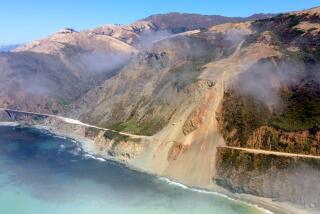Coastal Panel OKs Bridge Replacement
The California Coastal Commission on Tuesday approved plans to replace a deteriorating 1930s-era bridge over the San Gabriel River that links Seal Beach and Long Beach.
The new span will be built with half the number of existing traffic lanes to make room for a bike path and a landscaped median, and have airier handrails to allow for better views.
The commission unanimously approved the $5.7-million project in a 15-minute public hearing in Redondo Beach. Seal Beach and Long Beach received state and federal funds to replace the crumbling Marina Drive bridge, which Caltrans in 1993 determined to be in poor condition.
Officials were excited about starting the project, but said drawn-out dealings with the Coastal Commission have pushed it back at least a year.
âItâs about time. Weâve been faced with delay after delay after delay for a seemingly no-brainer of a project,â said Seal Beach Councilman Shawn Boyd. âItâs a bridge that needs replacement. Itâs unsafe for both vehicular traffic and pedestrian traffic.â
Teresa Henry, the commissionâs South Coast district manager, said the extra time was necessary to scrutinize the project and study alternatives that might have less of an environmental impact.
The San Gabriel River, which receives polluted runoff from 635 square miles of Orange, Los Angeles and San Bernardino counties, provides habitat for many fish and bird species, including terns, cormorants, brown pelicans, anchovies, sardines and mackerel.
The existing four-lane concrete bridge has cracked pavement, potholes bigger than phone books, narrow sidewalks and a rusty handrail with prison-like vertical metal bars.
The number of bridge supports also will be decreased, improving the view from afar as well as the wildlife habitat in the river below, said Karl Schwing, a planner with the commissionâs Long Beach office.
Seal Beach and Long Beach are paying for most of the project with funds from the Federal Highway Administrationâs highway bridge replacement and rehabilitation program and a state seismic retrofitting program. In the end, each city will pay about $342,000 of its own for the project, said Doug Dancs, director of public works in Seal Beach.
Construction is expected to begin March 15 and continue for two to three years. During the summers, workers will rebuild the bridge. In the rainy seasons, they will not be allowed to disturb the river channel, and will work on less obtrusive projects, Dancs said.
During the vast majority of construction, part of the bridge will remain open. Occasionally, drivers and pedestrians will be detoured.
As with any construction project, there will be delays in traffic, noise and other inconveniences for neighbors, Dancs said.
But, âat the end of the day, theyâll have a much nicer facility than they have now,â he said.
More to Read
Sign up for Essential California
The most important California stories and recommendations in your inbox every morning.
You may occasionally receive promotional content from the Los Angeles Times.











